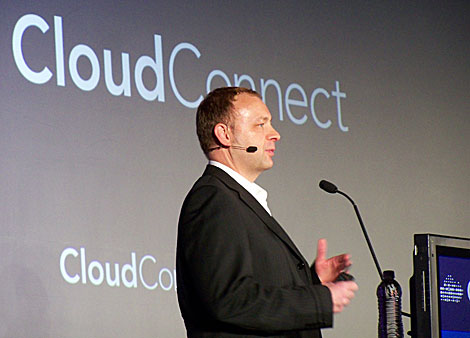
Bill Gillis, the Director of eHealth Technologies at Beth Israel Deaconess Medical Center, speaks Tuesday at Cloud Connect in Santa Clara, Calif. (Photo: Rich Miller).
SANTA CLARA, Calif. - Beth Israel Deaconess Medical Center didn't set out to build a healthcare cloud. When the Boston hospital adopted electronic health records (EHR)in 2007, it needed to find a way to include its physicians in the effort. That was a substantial challenge, since this meant creating a system that could work for 1,500 doctors in 300 offices in eastern Massachusetts. And it was critical that they get it right.
"The challenge was how to get this system out of them in a way that was secure and reliable," said Bill Gillis, Director of eHealth Technologies at Beth Israel Deaconess. "Adopting EHR means they won't have paper charts. If they don't have paper charts and the system doesn't work, then they may not be able to see patients that day."
Gillis shared his experience Tuesday in one of the keynotes at Cloud Connect, which brought together 3,500 cloud technologists at the Santa Clara Convention Center. Gillis said that the new system needed to be flexible, since the hospital couldn't be certain how many of the physicians would agree to convert to EHR and participate in the project.
"The solution was to build a cloud," he sad. "We really wanted to find tools that would work. It wasn't really until after we built it that people said 'hey, you built a private cloud.' For us, the idea to deploy this scalable product to our physician practices was really what we needed."
Getting Security Right
There were challenges. One of the biggest was security, given the paramount importance of patient privacy and the substantial regulatory requirements for hospitals. Gillis said working with VMware and third-party security specialists on vulnerabiity assessments and penetration testing was key to building confidence that the system would be secure. "a big part of the security piece was testing," he said.
The initial system was built as a private cloud, with the equipment and applications hosted and maintained in the Beth Israel Deaconess data center. But Gillis says his long-term hope is to move further into the cloud.
"We're hosting all this infrastructure," he said. "All I want to do is host the application. We really are looking towards going to a public/private cloud. Our long-term goal is to just provide a URL to our physicians."





